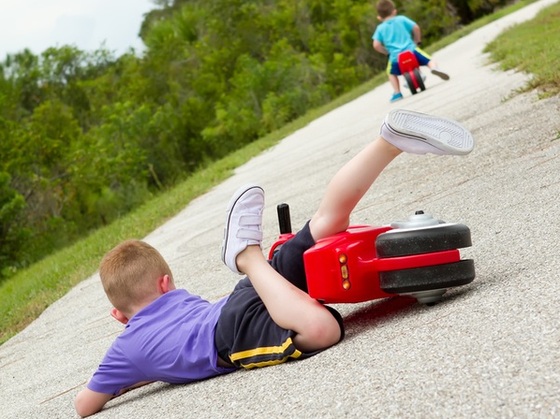It’s not always necessary. See what to watch out for and what action to take.
What a nice thing to watch a child taking its first little steps, isn’t it? And the child can barely walk and already wants to run. What happens? She falls. This is part of the daily lives of families.
And, due to a characteristic of the child’s physical proportion, especially below 2 years of age, the head is thrown forward in the fall.
Data from the Ministry of Health showed that in 2012, among the approximately 370,000 admissions for falls in Brazil, 16% were in children and adolescents aged 0 to 14 years.
A study published on the website of the NGO Criança Segura, in a survey requested by Datafolha (916 interviews, between August and November 2012, in 5 public hospitals in São Paulo), showed that falls were responsible for 48% of hospital admissions due to accidents, evaluating children up to 14 years of age, with 83% of them from babies under 1 year of age.
The most common falls are from their own height, without climbing anything, and in babies this accident is usually in their parents’ bed. Despite being a normal part of a child’s development, curiosity can have serious consequences.

Traumatic Brain Injury (TBI)
Scares, isn’t it? This is the technical name you use when someone falls and hits their head.
Even so, what terrifies parents most is not what is actually more serious. Whenever I am consulted in a fall situation, the biggest concern is whether my head is broken and whether an X-ray is needed. Although a skull fracture is not simple, the skull is a bone, the diagnosis can be made by a Simple skull x-ray but that’s not the biggest problem. A skull fracture is like a fracture of any bone: it will heal over time.
But can there be TBI without a skull fracture and still be very serious?
What matters is what happens inside the skull, in the brain: the bruises or hemorrhages (bleeding). And that doesn’t show up on a simple X-ray, only on a more complex exam, which, despite a large exposure to radiation, is essential for the diagnosis: computed tomography (cranial CT).
Depending on the area of the brain affected, the extent of bleeding, and the type of blood vessel affected (artery or vein), TBI can be mild, moderate, or severe.
When an artery has been injured, bleeding is more intense and care (almost always surgical) within the first 12 hours can be the fundamental differential in the prognosis of the condition. In this case, it is difficult to wake up the child, vomiting does not stop with a headache that increases with bleeding (intracranial hypertension).
If a vein has been affected, this blood loss is slower, but the child may get worse every day, the symptoms are milder, but they do not go away and surgery, if necessary, is not urgent.
Should every child who hit their head be taken to the emergency room?
If that were so, the parents wouldn’t go a week without getting urgent help. Children who have suffered small falls, which do not change their behavior, do not show signs of clinical or neurological changes, can wait at home, under observation.
But there are some situations that deserve a more urgent assessment, in case of falls. Between them:
- Accidents with bicycles (especially if the child is not wearing a helmet) or in the car;
- Every fall in a child under 3 months of age must be evaluated for the low resistance and protection of the skull in this age group;
- Falls from stairs of 5 or more steps (regardless of age) or from a height above one meter in children under 2 years of age or more than one and a half meters in children above that age;
- Fainting with seizures, loss of balance;
- If the faint with loss of consciousness lasts one minute, if there is nose or ear bleeding or bumps (cephalohematomas) that grow rapidly;
- At least 4 vomiting episodes within one hour of the fall;
- Headache that increases until it interferes with the child’s activity;
- If the child sleeps after the fall and there is difficulty waking him up.
An episode of vomiting, a little headache or a child who falls asleep doesn’t always need to be taken to an emergency room. It can let the child sleep, especially if it’s their sleep time.
IMPORTANT: NEVER MEDICATE A CHILD AFTER A TBI.
Symptoms, in this case, can be masked and do not give early warning of the need for urgent care.
If none of these symptoms appear in a child after a fall with TBI, keep an observation for at least 24 hours and only in case of worsening of symptoms seek emergency care in the emergency room.
Care to prevent accidents
A child on the move is an inexhaustible source of worry. A child alone in silence is not always out of danger. Falls, shocks, intoxications, suffocation, choking haunt and populate the nightmares of many parents and the lives of many children.
But if we are only concerned about illnesses and accidents, we will not be able to keep up with the beautiful growth and development of our children and we may even interfere negatively in this situation.
Although it sounds like a well-worn statement, prevention is always important. Every child must always be under the supervision of an adult. We must never let children play alone or in changing rooms, adult beds, bathtubs, even if it is “just for a minute to answer the phone or the door”.
